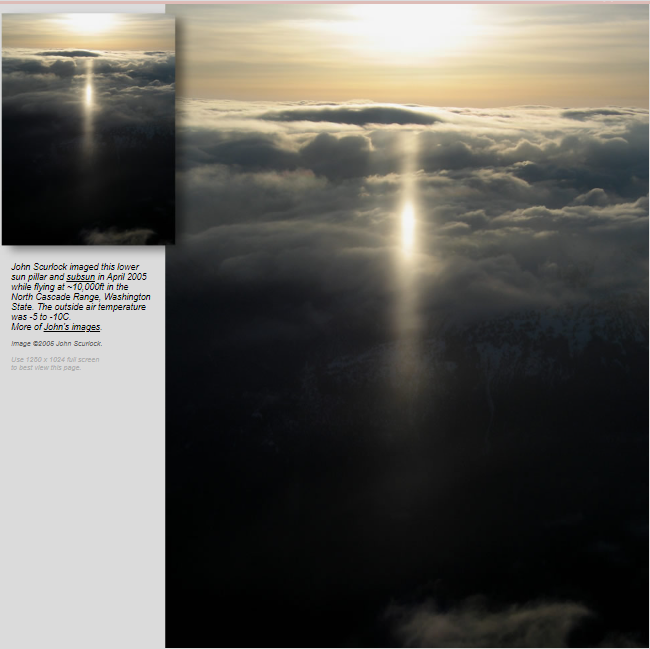Lower sun pillar and subsun
Exploring the Lower Sun Pillar and Subsun
Have you ever gazed up at the sky and noticed a captivating display of light pillars radiating from the Sun? One fascinating phenomenon that often accompanies these pillars is the lower sun pillar and subsun. These optical wonders can transform a mundane sky into a breathtaking spectacle. Let's delve deeper into the intricacies of the lower sun pillar and subsun and uncover the secrets behind their formation.
A Glimpse into the Lower Sun Pillar and Subsun
The lower sun pillar and subsun are atmospheric optical phenomena that occur when sunlight interacts with ice crystals suspended in the atmosphere. While sun pillars typically extend vertically above the Sun, the lower sun pillar descends below the solar disk, creating a mesmerizing extension of light. The subsun, on the other hand, appears as a bright spot directly below the Sun, resembling a mirror image of our celestial neighbor.
Unraveling the Science Behind the Lower Sun Pillar and Subsun
To understand the formation of these captivating features, we must first comprehend the role of ice crystals in the atmosphere. These microscopic ice particles, often found in high-altitude clouds, act as prisms that refract and reflect sunlight. When sunlight passes through these ice crystals, it undergoes a process known as scattering, resulting in the dispersion of light in various directions.
In the case of the lower sun pillar, horizontally oriented ice crystals play a crucial role. As sunlight enters these crystals, it is deflected vertically downwards, creating a stunning column of light below the Sun. This vertical deflection occurs due to the hexagonal shape of the ice crystals, which align themselves parallel to the ground. The length of the pillar depends on factors such as crystal size and distribution within the atmosphere.
The subsun, however, arises from a slightly different mechanism. It occurs when sunlight is reflected by ice crystals that are floating in the air, creating a mirror-like effect. These crystals are usually plate-shaped and align themselves with their flat surfaces parallel to the ground. The reflected light converges at a specific angle, resulting in the appearance of a bright spot directly below the Sun.
Atmospheric Conditions and Observations
The formation of the lower sun pillar and subsun is contingent upon specific atmospheric conditions. Cold temperatures, typically below freezing, are necessary for ice crystals to form and remain suspended in the air. Additionally, the presence of high-altitude clouds, such as cirrostratus or cirrus clouds, provides the ideal medium for these phenomena to occur.
Observing the lower sun pillar and subsun can be an awe-inspiring experience. The best time to witness these phenomena is during sunrise or sunset when the Sun is closer to the horizon. The low angle of the Sun allows for a more pronounced display of the pillars and subsun. It is important to note that these optical phenomena are relatively rare, making their sighting all the more captivating.
Similar Phenomena and Associated Myths
The lower sun pillar and subsun are part of a larger family of atmospheric optical phenomena called halos. Halos encompass a wide range of intriguing displays, including sundogs, circumzenithal arcs, and 22-degree halos. These phenomena often occur simultaneously or in conjunction with each other, creating a symphony of light in the sky.
Throughout history, these captivating optical phenomena have given rise to various myths and folklore. In some cultures, the subsun is believed to be a celestial gateway or a portal to another world. Others interpret these phenomena as omens of impending change or significant events. While these interpretations may be rooted in ancient beliefs, it is important to approach them with a scientific understanding of their true nature.
Capturing the Beauty
Photographing the lower sun pillar and subsun can be a rewarding endeavor for both amateur and professional photographers. To capture these optical wonders, it is essential to use a camera with manual settings and a sturdy tripod. Adjusting the exposure settings and utilizing techniques such as bracketing can help capture the intricate details of the pillars and subsun.
Remember, patience is key when photographing atmospheric optics. These phenomena are transient and can disappear within minutes, making timing crucial. By keeping a keen eye on weather conditions and positioning yourself in an open area away from obstructions, you increase your chances of capturing these ethereal displays.
Awe-Inspiring Wonders of the Sky
The lower sun pillar and subsun offer us a glimpse into the beauty and complexity of our atmosphere. These optical phenomena remind us of the intricate interplay between light and ice crystals suspended high above our heads. By taking the time to appreciate and understand these phenomena, we gain a deeper appreciation for the wonders that unfold in the sky above us.
Next time you find yourself gazing at a stunning sunrise or sunset, take a moment to search for these captivating features. With a bit of luck and the right atmospheric conditions, you may witness the enchanting display of the lower sun pillar and subsun, leaving you in awe of the natural wonders that surround us.

John Scurlock imaged this lower sun pillar and subsun in April 2005 while flying at ~10,000ft in the North Cascade Range, Washington State. The outside air temperature was -5 to -10C.
More of John's images.
Image ©2005 John Scurlock.
Use 1280 x 1024 full screen to best view this page.
Note: this article has been automatically converted from the old site and may not appear as intended. You can find the original article here.
Reference Atmospheric Optics
If you use any of the definitions, information, or data presented on Atmospheric Optics, please copy the link or reference below to properly credit us as the reference source. Thank you!
-
<a href="https://atoptics.co.uk/blog/lower-sun-pillar-and-subsun/">Lower sun pillar and subsun</a>
-
"Lower sun pillar and subsun". Atmospheric Optics. Accessed on November 26, 2024. https://atoptics.co.uk/blog/lower-sun-pillar-and-subsun/.
-
"Lower sun pillar and subsun". Atmospheric Optics, https://atoptics.co.uk/blog/lower-sun-pillar-and-subsun/. Accessed 26 November, 2024
-
Lower sun pillar and subsun. Atmospheric Optics. Retrieved from https://atoptics.co.uk/blog/lower-sun-pillar-and-subsun/.